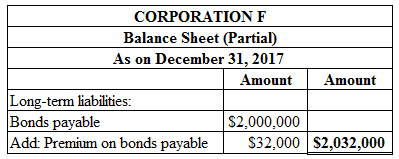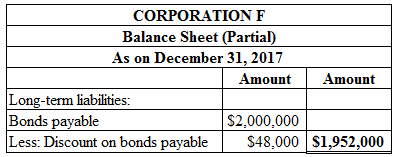
(a)
Bonds
Bonds are a kind of interest bearing notes payable, usually issued by companies, universities and governmental organizations. It is a debt instrument used for the purpose of raising fund of the corporations or governmental agencies. If selling price of the bond is equal to its face value, it is called as par on bond. If selling price of the bond is lesser than the face value, it is known as discount on bond. If selling price of the bond is greater than the face value, it is known as premium on bond.
To Prepare: The
(a)
Answer to Problem 10.8AP
Prepare the journal entry to record the issuance of bonds of Corporation F on January 1, 2017as shown below:
| Date | Account title and Explanation | Debit | Credit |
| January 1, 2017 | Cash (1) | $2,040,000 | |
| Premium on bonds payable (2) | $40,000 | ||
| Bonds payable | $2,000,000 | ||
| (To record the issuance of bonds payable at premium value for Corporation F ) |
Table (1)
Working notes:
Calculate Cash received from issuance of bonds payable of Corporation F as shown below:
Calculate premium on bonds payable of Corporation F as shown below:
Explanation of Solution
- Cash is a current asset, and increased. Therefore, debit cash account for $2,040,000.
- Premium on bonds payable is a contra liability, and increased. Therefore, credit premium on bonds payable for $40,000.
- Bonds payable is a long-term liability, and increased. Therefore, credit bonds payable account for $2,000,000.
To Prepare: The journal entry to record the accrued interest expense, and premium on amortize bond for Corporation F on December 31, 2017.
Answer to Problem 10.8AP
Prepare the journal entry to record the accrued interest expense and premium on amortize bond for Corporation F on December 31, 2017 as shown below:
| Date | Account title and Explanation | Debit | Credit |
| December 31, 2017 | Interest expense (3) | $132,000 | |
| Premium on bonds payable (1) | $8,000 | ||
| Interest payable (2) | $140,000 | ||
| (To record the accrued interest expense and premium on amortize bond for Corporation F) |
Table (2)
Working notes:
Calculate premium of bonds payable for Corporation F as shown below:
Calculate interest payable amount of Corporation F as shown below:
Calculate interest expense of Corporation F as shown below:
Explanation of Solution
- Interest expense is a component of
stockholders’ equity , and decreased it. Therefore, debit interest expense account for $132,000. - Premium on bonds payable is a contra liability, and decreased. Therefore, debit premium on bonds payable for $8,000.
- Interest payable is a
- current liability, and increased. Therefore, credit interest payable account for $140,000.
(b)
To Prepare: The journal entry to record the issuance of bonds of Corporation F on January 1, 2017.
(b)
Answer to Problem 10.8AP
Prepare the journal entry to record the issuance of bonds of Corporation F on January 1, 2017as shown below:
| Date | Account title and Explanation | Debit | Credit |
| January 1, 2017 | Cash (1) | $1,940,000 | |
| Discount on bonds payable (2) | $60,000 | ||
| Bonds payable | $2,000,000 | ||
| (To record the issuance of bonds payable at discount value for Corporation F ) |
Table (3)
Working notes:
Calculate Cash received from issuance of bonds payable of Corporation F as shown below:
Calculate discount on bonds payable of Corporation F as shown below:
Explanation of Solution
- Cash is a current asset, and increased. Therefore, debit cash account for $1,940,000.
- Discount on bonds payable is a contra liability, and decreased. Therefore, debit discount on bonds payable for $60,000.
- Bonds payable is a long-term liability, and increased. Therefore, credit bonds payable account for $2,000,000.
To Prepare: The journal entry to record the accrued interest expense and premium on amortize bond for Company O on December 31, 2017.
Answer to Problem 10.8AP
Prepare the journal entry to record the accrued interest expense and premium on amortize bond for Company O on December 31, 2017 as shown below:
| Date | Account title and Explanation | Debit | Credit |
| December 31, 2017 | Interest expense (3) | $152,000 | |
| Discount on bonds payable (1) | $12,000 | ||
| Interest payable (2) | $140,000 | ||
| (To record the accrued interest expense and discount on amortize bond for Corporation F) |
Table (4)
Working notes:
Calculate discount of bonds payable for Company O as shown below:
Calculate interest payable amount of Company O as shown below:
Calculate interest expense of Company O as shown below:
Explanation of Solution
- Interest expense is a component of stockholders’ equity, and decreased it. Therefore, debit interest expense account for $152,000.
- Discount on bonds payable is a contra liability, and increased. Therefore, credit discount on bonds payable for $12,000.
- Interest payable is a current liability, and increased. Therefore, credit interest payable account for $152,000.
(c-1)
To Prepare: The
(c-1)
Answer to Problem 10.8AP
Prepare the balance sheet presentation for issuance of bonds at December 31, 2017 using the selling price of $102 as shown below:

Figure (1)
Explanation of Solution
Premium on bonds payable for the year 2017 is $32,000 which is calculated by deducting from premium on amortize of bond for the year 2017 is $8,000 from premium on bonds payable on January 1, 2017 is $40,000.
(c-2)
To Prepare: The balance sheet presentation for issuance of bonds at December 31, 2017 using the selling price of $97.
(c-2)
Answer to Problem 10.8AP
Prepare the balance sheet presentation for issuance of bonds at December 31, 2017 using the selling price of $97 as shown below:

Figure (2)
Explanation of Solution
Discount on bonds payable for the year 2017 is $48,000 which is calculated by deducting from discount on amortization of bond for the year 2017 for $12,000, from discount on bonds payable on January 1, 2017 for $60,000.
Want to see more full solutions like this?
Chapter 10 Solutions
Financial Accounting 8th Edition
- What is the result of this exchange?arrow_forwardprovide step by step solution for general accountingarrow_forwardPablo Foods Ltd. acquires all the outstanding stock of Northern Harvest Inc. for $15 million. The fair value of Northern Harvest's assets is $10.4 million, and the fair value of its liabilities is $2.1 million. Calculate the amount paid for goodwill.arrow_forward
- Need answer accurate please No AI i will rate unhelpful.arrow_forwardsolve thi q general accountingarrow_forwardCalculate the Operating Cash Flow (OCF) from the following data: • Change in net fixed assets: $18,000 • Change in net working capital: $22,000 Dividends Paid: $28,000 • Depreciation Expense: $32,000 . Interest Paid: $19,000 • Net New Borrowing: $14,000 • Net New Equity Issued: $9,000arrow_forward
- Hannah Brooks receives a travel allowance of $220 each week from her company for time away from home. If this allowance is taxable and she has a 25 percent income tax rate, what amount will she have to pay per year in taxes for this employee benefit? a. $5250 b. $5500 c. $2,860 d. $4880arrow_forwardPlease dont answer if you can't read the values in image . I will give unhelpful.arrow_forwarddear expert , dont answer if you cant understand values.Please comment i will write values . I will give unhelpful.arrow_forward
 Financial AccountingAccountingISBN:9781305088436Author:Carl Warren, Jim Reeve, Jonathan DuchacPublisher:Cengage LearningPrinciples of Accounting Volume 1AccountingISBN:9781947172685Author:OpenStaxPublisher:OpenStax College
Financial AccountingAccountingISBN:9781305088436Author:Carl Warren, Jim Reeve, Jonathan DuchacPublisher:Cengage LearningPrinciples of Accounting Volume 1AccountingISBN:9781947172685Author:OpenStaxPublisher:OpenStax College Intermediate Accounting: Reporting And AnalysisAccountingISBN:9781337788281Author:James M. Wahlen, Jefferson P. Jones, Donald PagachPublisher:Cengage Learning
Intermediate Accounting: Reporting And AnalysisAccountingISBN:9781337788281Author:James M. Wahlen, Jefferson P. Jones, Donald PagachPublisher:Cengage Learning


